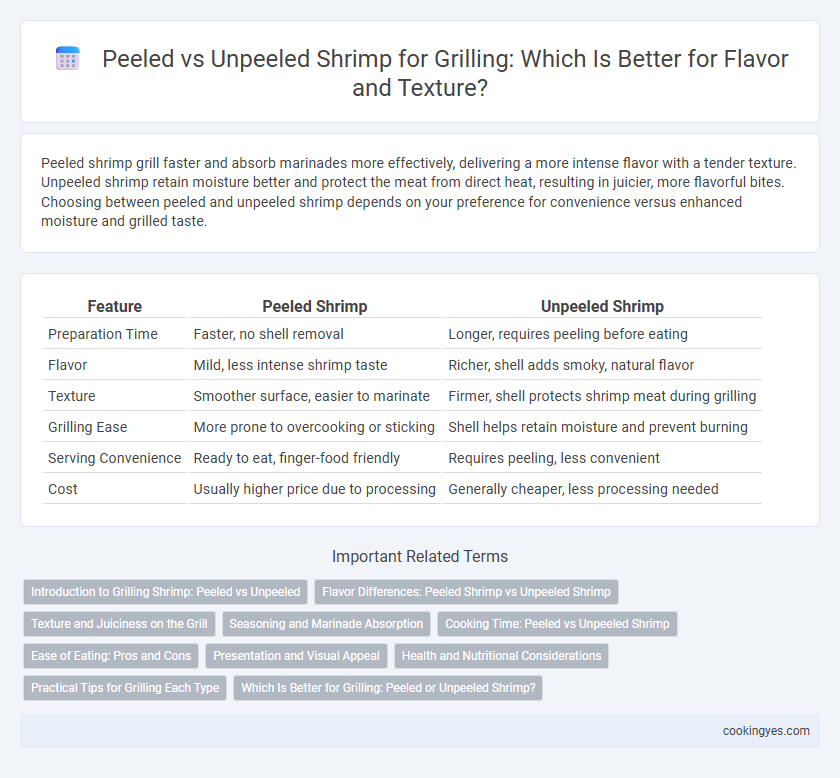Peeled shrimp grill faster and absorb marinades more effectively, delivering a more intense flavor with a tender texture. Unpeeled shrimp retain moisture better and protect the meat from direct heat, resulting in juicier, more flavorful bites. Choosing between peeled and unpeeled shrimp depends on your preference for convenience versus enhanced moisture and grilled taste.
Table of Comparison
| Feature | Peeled Shrimp | Unpeeled Shrimp |
|---|---|---|
| Preparation Time | Faster, no shell removal | Longer, requires peeling before eating |
| Flavor | Mild, less intense shrimp taste | Richer, shell adds smoky, natural flavor |
| Texture | Smoother surface, easier to marinate | Firmer, shell protects shrimp meat during grilling |
| Grilling Ease | More prone to overcooking or sticking | Shell helps retain moisture and prevent burning |
| Serving Convenience | Ready to eat, finger-food friendly | Requires peeling, less convenient |
| Cost | Usually higher price due to processing | Generally cheaper, less processing needed |
Introduction to Grilling Shrimp: Peeled vs Unpeeled
Grilling peeled shrimp allows for quicker cooking and easier seasoning absorption, enhancing flavor intensity, while unpeeled shrimp provide a protective barrier that retains moisture and imparts a smoky, charred taste. The shell shields the delicate meat from direct heat, reducing the risk of overcooking and preserving juiciness. Choosing between peeled or unpeeled shrimp depends on desired texture, grilling time, and flavor preferences.
Flavor Differences: Peeled Shrimp vs Unpeeled Shrimp
Unpeeled shrimp retain their shells during grilling, which helps preserve natural juices and enhances a richer, brinier flavor due to the caramelization of the shell's proteins. Peeled shrimp cook faster and allow marinades and seasonings to penetrate the flesh more directly, resulting in a more pronounced seasoning impact but less inherent shell flavor. Grilling unpeeled shrimp typically produces a slightly firmer texture and deeper umami notes, while peeled shrimp offer a more delicate taste with an emphasis on the added spices and sauces.
Texture and Juiciness on the Grill
Peeled shrimp grill faster, offering a tender texture and allowing direct heat to enhance juiciness by caramelizing the surface. Unpeeled shrimp retain their shells, which act as a natural barrier, preserving moisture and delivering a slightly firmer texture with added flavor from the shell. Choosing peeled or unpeeled shrimp affects grilling time, texture crispness, and the juiciness retained within each bite.
Seasoning and Marinade Absorption
Peeled shrimp allow marinades and seasonings to penetrate directly into the flesh, resulting in more intense and evenly distributed flavors during grilling. Unpeeled shrimp retain their shells, which act as a barrier that can limit seasoning absorption but help retain moisture and offer a smoky, charred taste. Choosing peeled shrimp enhances flavor infusion, while unpeeled shrimp provide juiciness and a natural protection that affects the seasoning profile.
Cooking Time: Peeled vs Unpeeled Shrimp
Peeled shrimp generally cook faster on the grill, typically requiring about 2 to 3 minutes per side due to direct heat exposure, while unpeeled shrimp take slightly longer, around 3 to 4 minutes per side, as the shell acts as a protective barrier slowing heat penetration. The shell helps retain moisture and flavor during grilling, making unpeeled shrimp juicier but increasing cooking time. For precise cooking, monitoring shrimp color and firmness is essential regardless of peeling status to avoid overcooking.
Ease of Eating: Pros and Cons
Peeled shrimp offer superior ease of eating on the grill, eliminating the need to remove shells and allowing for immediate consumption, which is ideal for casual gatherings. Unpeeled shrimp retain more moisture and flavor during grilling but require peeling after cooking, which may be less convenient and messier for some diners. Choosing peeled shrimp enhances convenience and speed, while unpeeled shrimp provide a richer grilling experience with added taste complexity.
Presentation and Visual Appeal
Peeled shrimp offer a cleaner and more uniform appearance on the grill, enhancing presentation with their smooth, exposed flesh that easily absorbs marinades and seasoning colors. Unpeeled shrimp provide a rustic, natural look with their shells adding texture and visual contrast, making the dish appear more authentic and flavorful. The choice between peeled and unpeeled shrimp can significantly affect the visual appeal, with peeled shrimp emphasizing elegance and unpeeled shrimp highlighting a vibrant, hearty presentation.
Health and Nutritional Considerations
Peeled shrimp offer easier access to nutrients and reduce the risk of ingesting contaminants trapped in the shell, making them a healthier choice for grilling. Unpeeled shrimp may retain more moisture and flavor, but their shells can harbor bacteria or residues, potentially affecting food safety. Choosing peeled shrimp ensures better hygiene and nutrient absorption, enhancing the overall nutritional benefits of grilled shrimp dishes.
Practical Tips for Grilling Each Type
Peeled shrimp grill faster and absorb marinades more effectively, making them ideal for quick cooking and even seasoning distribution. Unpeeled shrimp retain moisture and have a natural barrier that protects them from direct heat, preventing overcooking and adding flavor from the shell. For best results, grill peeled shrimp for 2-3 minutes per side and unpeeled shrimp for 4-5 minutes per side over medium-high heat.
Which Is Better for Grilling: Peeled or Unpeeled Shrimp?
Unpeeled shrimp retain their natural moisture and flavor during grilling, providing a juicier and more flavorful result due to the protective shell. Peeled shrimp cook faster and allow marinades to penetrate more deeply, but they are prone to drying out if overcooked. For optimal grilling, unpeeled shrimp are generally preferred as the shell acts as a barrier against direct heat and helps preserve tenderness.
Peeled vs unpeeled shrimp for grilling Infographic

 cookingyes.com
cookingyes.com